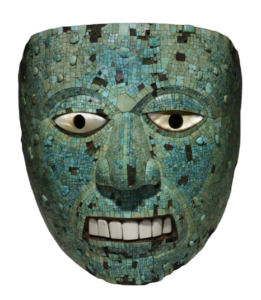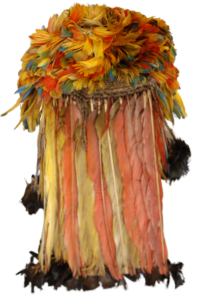Shitikari: Starscape Sheroanawe Hakiihiwe 2019,2016.1 ©Trustees of the British Museum. |
 |
The Centre
The Santo Domingo Centre of Excellence for Latin American Research (SDCELAR) at the British Museum is dedicated to developing and supporting collection-based projects by collaborating with communities in Latin America and the Caribbean. In fostering a growing network of heritage communities, researchers, artists, and partners with the Museum, SDCELAR aims to:

Mexica-Mixtec wooden mask covered in turquoise mosaic and other precious materials. Am,St.400 ©Trustees of the British Museum
Our staff conducts field research across Latin America and the Caribbean to identify projects that can expand our understanding of the region’s history, culture, and politics and join ongoing conversations around heritage initiatives and museum practices around the world. We build creative connections between Latin America and the British Museum’s collections from that region.
The Museum holds around 62,000 works from Central and South America that span 13,000 years of human history and encapsulate diverse cultural knowledge. We promote the research of these objects and their unique histories, and support activities that show how museum collections can carry and create new meanings for different societies across the globe.
We support transdisciplinary research that is able to level different knowledge systems –including but not limited to Academia– alongside artistic expressions and alternative forms of critical engagement with collections. Our projects range from collaborative curation, artistic residencies, and scientific analysis to archival digitization, 3D modelling, digital exhibitions, and more.

Munduruku “coifa” style headdress made of macaw feathers. Am1913,1114.93 © Trustees of the British Museum
SDCELAR promotes participatory interpretation and self-representation through the cocreation of project pages that are shared with the public online on the Centre’s website. By doing so, this digital platform advocates for both transdisciplinarity and plurivocality, as much as it makes space for the oftentimes neglected voices of diversity throughout the historical and cultural narratives it wishes to portray.
SDCELAR’s website and its coauthored project pages are creative and innovative tools that help bringing together and levelling different types of knowledge. This digital asset ultimately seeks to engender intercultural and multi-directional conversations about heritage, while fostering a more horizontal communication and relationship among the Centre’s network of collaborators across Latin America.
This platform also aims to diversify historical and cultural narratives by facilitating communication between our affiliate researchers across Central and South America, to promote intercultural and multi-directional conversations about cultural heritage
While the institution develops and manages collections research and intellectual community relationships, the public is often only presented with the final product of these projects. In this process, the details of museum projects and large parts of the collection remain hidden. This digital platform will present the Centre’s ongoing activities and create a dialogue between the many global communities that are interested in cultural and archaeological heritage.